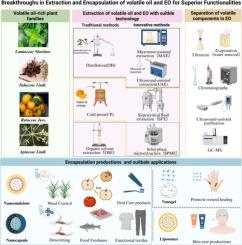在挥发油和精油的提取和包封方面取得突破性进展,具有优越的功能
IF 22
1区 材料科学
Q1 MATERIALS SCIENCE, MULTIDISCIPLINARY
引用次数: 0
摘要
挥发油(在一些研究中也称为精油)含有丰富的萜类、醇类等生物活性成分,广泛应用于医药、食品、化妆品和农业等领域。然而,它们的挥发性高、水溶性低、光敏性差,极大地限制了它们的实际应用。本文系统分析了近200篇相关文献,明确了芜科、唇科和十字花科是植物挥发油的常见来源,萜类化合物是其主要成分。对超临界流体萃取等10余种传统和新兴的提取分离技术进行了研究,无溶剂微波萃取联合超声预处理可使芦花果皮精油得率提高26%。同时,综述了纳米胶囊、脂质体等10多种有效提高挥发油稳定性和生物活性的包封形式。在多用途层面,纳米乳液和酸洗乳液在护肤领域表现突出,纳米颗粒和纳米胶囊在纺织品和食品调味领域得到广泛应用,纳米水凝胶成为新型的药物递送载体,多种形式全面突破了精油的应用局限。但新的提取分离技术存在成本高、操作复杂、难以适应工业化生产等问题;而封装技术面临着精油易分散、难以适应基底、材料安全性存疑、缺乏监测手段等挑战。本文突破了传统单一研究的局限,构建了“化学成分-提取技术-包封工艺-多元应用”的多维研究框架,为挥发油和精油领域的研究和产业发展提供了新的视角和理论支撑。本文章由计算机程序翻译,如有差异,请以英文原文为准。

Breakthroughs in extraction and encapsulation of volatile oil and essential oil for superior functionalities
Volatile oils (also called essential oils (EO) in some studies) are rich in terpenoids, alcohols and other bioactive components, and are widely used in medicine, food, cosmetics and agriculture. However, their high volatility, low water solubility and photo-thermal sensitivity have greatly restricted practical applications. This review systematically analyzed nearly 200 related literatures, and clarified that Rutaceae, Labiatae and Cruciferae are the common sources of plant volatile oils, and terpenoids are their main components. More than 10 traditional and emerging extraction and separation techniques, such as supercritical fluid extraction, were investigated, moreover, solvent-free microwave extraction combined with ultrasonic pretreatment increased the yield of essential oil from the rutaceae pericarp by 26%. Meanwhile, more than 10 encapsulation forms, such as nanocapsules and liposomes, which can effectively improve the stability and bioactivity of volatile oils, were summarized. At the level of multiple applications, nanoemulsions and pickering emulsions are outstanding in skin care, nano-particles and nano-capsules are widely used in textiles and food flavouring, and nano hydrogels have become a new type of carrier for drug delivery, and the multiple forms break the limitations of the application of essential oils in an all-round way. However, the new extraction and separation technologies have the problems of high cost, complicated operation, and difficult to be adapted to industrial production; and the encapsulation technologies face the challenges of easy essential oil dispersion, difficult to be adapted to the substrate, doubtful material safety, and lack of monitoring means. This paper breaks through the limitation of traditional single research by constructing a multi-dimensional research framework of ‘chemical composition-extraction technology-encapsulation process-diversified applications’, which provides a new perspective and theoretical support for the research and industrial development in the field of volatile oils and EO.
求助全文
通过发布文献求助,成功后即可免费获取论文全文。
去求助
来源期刊

Materials Today
工程技术-材料科学:综合
CiteScore
36.30
自引率
1.20%
发文量
237
审稿时长
23 days
期刊介绍:
Materials Today is the leading journal in the Materials Today family, focusing on the latest and most impactful work in the materials science community. With a reputation for excellence in news and reviews, the journal has now expanded its coverage to include original research and aims to be at the forefront of the field.
We welcome comprehensive articles, short communications, and review articles from established leaders in the rapidly evolving fields of materials science and related disciplines. We strive to provide authors with rigorous peer review, fast publication, and maximum exposure for their work. While we only accept the most significant manuscripts, our speedy evaluation process ensures that there are no unnecessary publication delays.
 求助内容:
求助内容: 应助结果提醒方式:
应助结果提醒方式:


